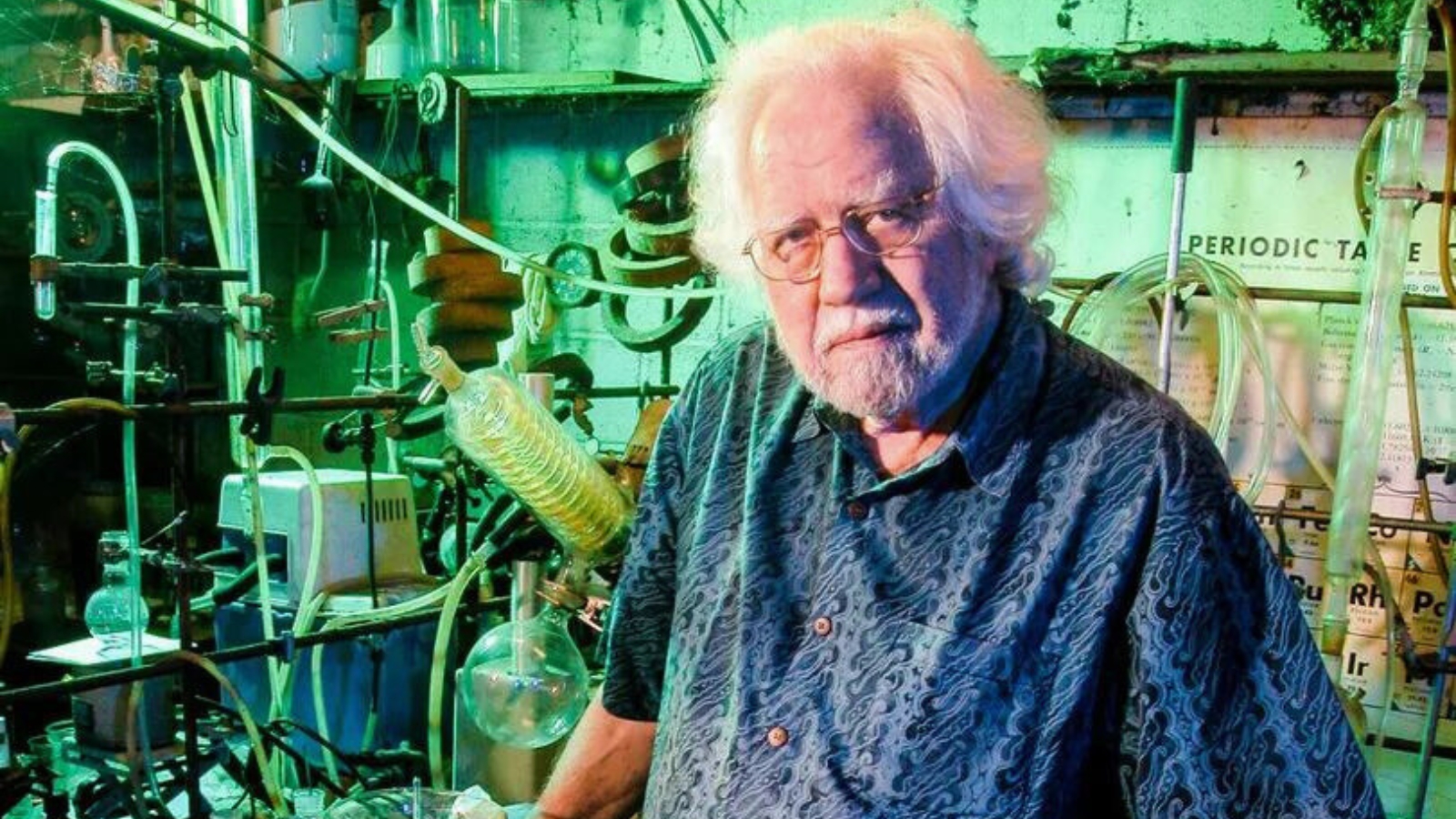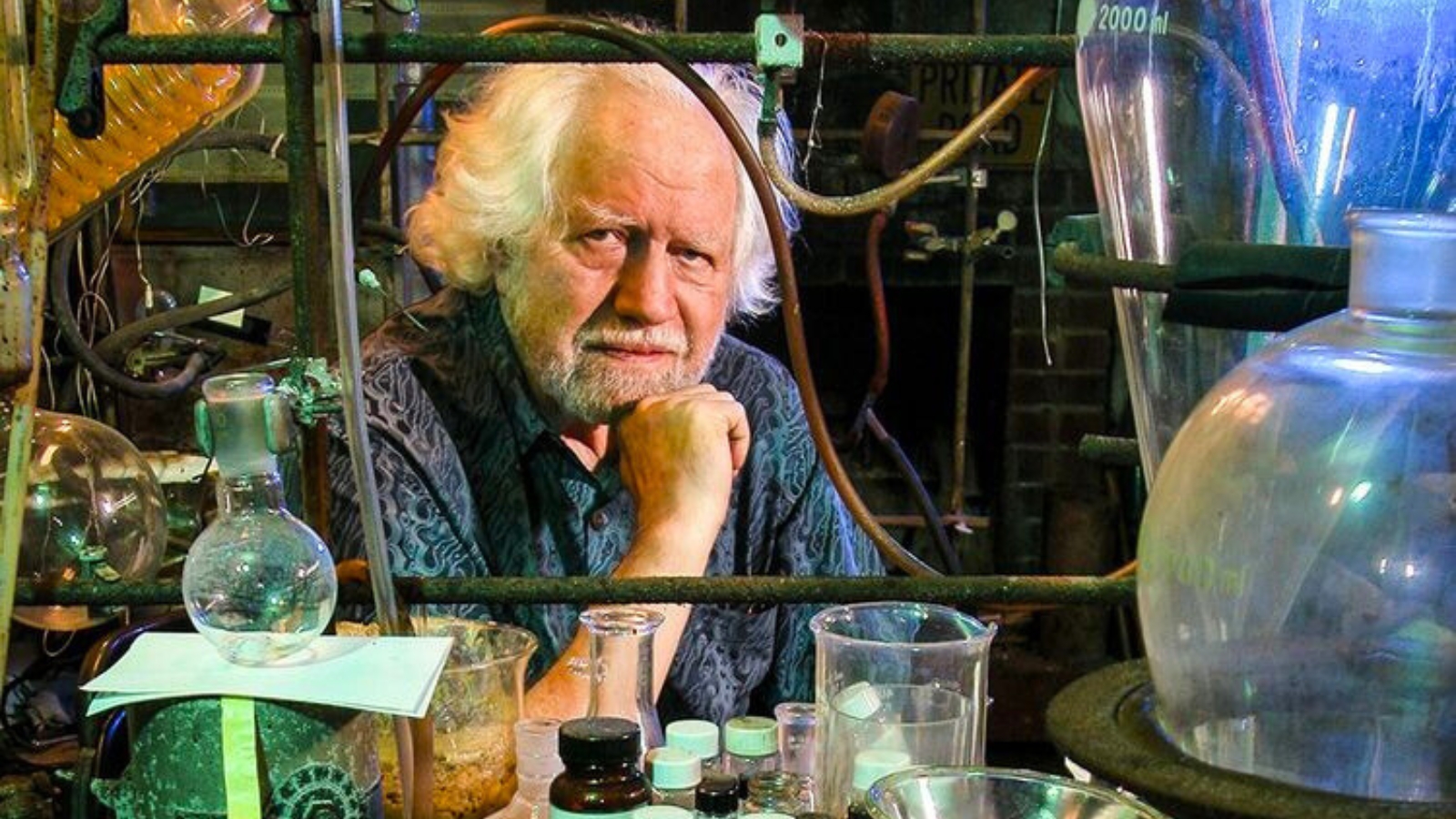In the vast expanse of psychedelic exploration, few names shine as brightly as Alexander “Sasha” Shulgin. Known as the godfather of psychedelics, Shulgin’s groundbreaking synthesis and personal experimentation with psychoactive substances have paved the way for a modern renaissance in psychedelic research and therapy.
Beyond his scientific prowess, Shulgin’s passion and curiosity have inspired a generation to explore the therapeutic and spiritual potential of psychedelics.

Shulgin’s History
Shulgin’s journey into the heart of psychedelic exploration began with a profound interest in the chemistry of the mind and its potential to unlock new realms of human consciousness. After completing his Ph.D. in biochemistry from the University of California, Berkeley, Shulgin joined Dow Chemical Company, where he synthesized Zectran, an early biodegradable insecticide. However, his most impactful work unfolded in his research laboratory at “Shulgin Farm,” his home.
At Shulgin Farm, nestled in the rolling hills of Northern California, Sasha, alongside his wife Ann Shulgin, embarked on a remarkable and unconventional journey into the study of psychoactive substances.
“The most compelling insight of that day was that this landscape of unimaginable color and beauty was not a foreign land but that it was a part of myself and that it was my choice whether it would be hidden from my day-to-day experience.”
– Sasha Shulgin, describing his experiences with psychedelics.
This collaboration between Sasha’s chemical genius and Ann’s deep understanding of psychotherapy and the human psyche led to the discovery and synthesis of numerous psychoactive compounds. Together, they created a unique and synergistic partnership that explored the therapeutic potentials of these substances.
Beyond their scientific and literary contributions, Sasha and Ann Shulgin’s work at Shulgin Farm created a vibrant intellectual and cultural hub for the psychedelic community. Their open and inclusive approach to exploring consciousness attracted scientists, therapists, artists, and explorers from around the world, fostering a rich exchange of ideas and experiences. The Shulgins’ commitment to rigorous scientific inquiry, combined with a profound respect for the subjective experience of psychoactive substances, has left an indelible mark on the field of psychedelic research.

Contributions to the Psychedelic Space
Shulgin’s contributions to the psychedelic space are vast, encompassing groundbreaking scientific research, influential writings, and advocacy for the thoughtful exploration of psychoactive substances. His work has significantly shaped the field of psychedelic science and culture, leaving a legacy that continues to influence and inspire.
One of Shulgin’s most notable scientific contributions is the synthesis and discovery of over 230 psychoactive compounds, including the popularization of MDMA (ecstasy) among psychologists in the 1970s and 1980s. This work expanded the repertoire of substances available for therapeutic use and research, opening new avenues for understanding the human mind and its healing potential.
Shulgin’s methodical approach to synthesizing these compounds, coupled with his detailed self-experimentation, provided invaluable insights into their effects, safety, and therapeutic potential.
“Sasha Shulgin is a true scientific pioneer whose work has expanded the range of possibilities for the therapeutic use of psychedelics. His courage and curiosity have paved the way for a new era of psychedelic research.”
– Rick Doblin, Founder of MAPS
Beyond his laboratory work, Shulgin’s writings, particularly PIHKAL and TIHKAL, co-authored with his wife Ann, have become seminal texts in the psychedelic community. These books offer an unprecedented blend of chemical synthesis guides, personal experimentations, and philosophical reflections on the nature of consciousness. Through these writings, Shulgin demystified the chemistry of psychedelics, making it accessible to a broader audience and encouraging responsible exploration and scientific inquiry.
Shulgin’s advocacy for the responsible use and legal study of psychoactive substances has also been a crucial aspect of his contribution to the psychedelic space. His open dialogue about the potentials and risks associated with these compounds has fostered a more informed and balanced public discourse on psychedelics. Moreover, his willingness to share his findings and methodologies openly has encouraged ethical research and exploration within the community.
“Shulgin’s legacy is not just in the molecules he synthesized but in the consciousness he awakened in others.”
– Alexander Zaitchik, Journalist
Shulgin’s Impact on 2C-B
Shulgin’s exploration and documentation of psychoactive substances have significantly impacted the understanding and use of many compounds, including 2C-B. Originally synthesized by another chemist in the 1970s, 2C-B was popularized and extensively researched by Shulgin, who included it in his seminal work, PIHKAL: A Chemical Love Story. His detailed account of 2C-B’s effects, dosage, and synthesis played a pivotal role in its adoption within therapeutic contexts and recreational settings.
Shulgin’s Introduction to 2C-B
Shulgin’s interest in phenethylamines led him to explore 2C-B (2,5-dimethoxy-4-bromophenethylamine), a substance he described as having a unique blend of psychedelic and entactogenic effects. Through his methodical self-experimentation and observation, Shulgin cataloged 2C-B’s capacity to induce euphoria, enhance visual perception, and facilitate emotional openness, all with a relatively mild and manageable duration of effect. His findings, shared in PIHKAL, offered the world a comprehensive look at 2C-B, advocating its potential benefits and responsible use.
Contribution to Psychedelic Science and Therapy:
Shulgin’s work with 2C-B extended beyond personal exploration, influencing the substance’s use in psychotherapy during the 1980s and 1990s. Therapists interested in the therapeutic potential of psychedelics considered 2C-B a valuable tool for exploring consciousness and facilitating deep psychological work, thanks to its clarity of mind and empathogenic qualities. Although the legal status of 2C-B has since changed, leading to a decrease in its therapeutic use, Shulgin’s research continues to inform contemporary studies on related compounds.

Celebrate the Shulgin Legacy: The Shulgin Foundation
The Shulgin Foundation is dedicated to preserving and advancing the legacy of Ann and Sasha Shulgin. As a nonprofit organization, it is committed to promoting education, research, and harm reduction in the field of psychedelics and psychoactive substances. The foundation fosters community and connection, ensuring that the values and groundbreaking work of the Shulgins continue to inspire and influence future generations.
A central goal of The Shulgin Foundation is to preserve “The Farm” — the iconic home and laboratory of Ann and Sasha. This historic site is envisioned as a center for education, research, and interdisciplinary events that encourage the cross-pollination of ideas within the psychedelic community. By maintaining this unique location, the foundation aims to keep the spirit of innovation and exploration alive.
The Shulgin Foundation proudly collaborates with a diverse range of organizations and individuals who share a commitment to responsibly advancing the understanding and use of psychedelics. This collective effort underscores the importance of unity in achieving the foundation’s objectives and honoring the profound impact of the Shulgins’ work.
Visit the Shulgin Foundation website to learn more about the foundation and contribute to the preservation of this invaluable legacy. Your participation, whether through education, research support, or community involvement, can make a difference in promoting the responsible exploration of psychedelics and psychoactive substances. Join us in celebrating and continuing the pioneering work of Ann and Sasha Shulgin.















